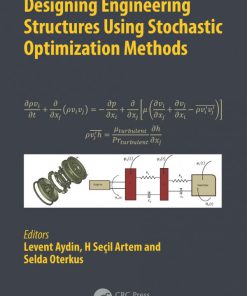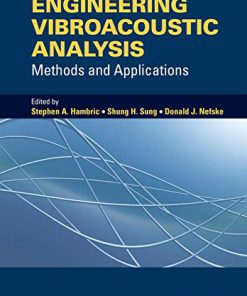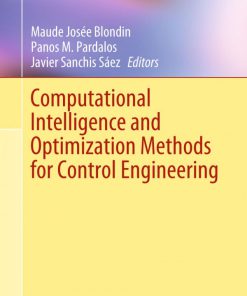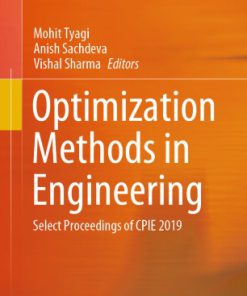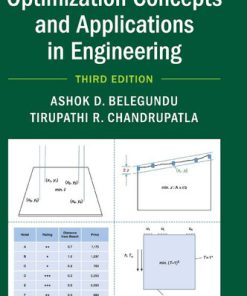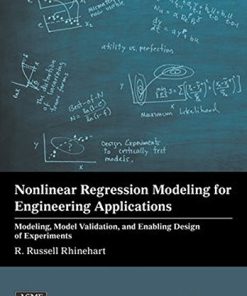Engineering optimization: applications, methods and analysis 1st Edition by R. Russell Rhinehart ISBN 1118936337 9781118936337
$50.00 Original price was: $50.00.$25.00Current price is: $25.00.
Engineering optimization: applications, methods and analysis 1st Edition by R. Russell Rhinehart – Ebook PDF Instant Download/Delivery: 1118936337, 978-1118936337
Full download Engineering optimization: applications, methods and analysis 1st Edition after payment
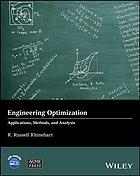
Product details:
ISBN 10: 1118936337
ISBN 13: 978-1118936337
Author: R. Russell Rhinehart
An Application-Oriented Introduction to Essential Optimization Concepts and Best Practices
Optimization is an inherent human tendency that gained new life after the advent of calculus; now, as the world grows increasingly reliant on complex systems, optimization has become both more important and more challenging than ever before. Engineering Optimization provides a practically-focused introduction to modern engineering optimization best practices, covering fundamental analytical and numerical techniques throughout each stage of the optimization process.
Although essential algorithms are explained in detail, the focus lies more in the human function: how to create an appropriate objective function, choose decision variables, identify and incorporate constraints, define convergence, and other critical issues that define the success or failure of an optimization project.
Examples, exercises, and homework throughout reinforce the author’s “do, not study” approach to learning, underscoring the application-oriented discussion that provides a deep, generic understanding of the optimization process that can be applied to any field.
Providing excellent reference for students or professionals, Engineering Optimization:
- Describes and develops a variety of algorithms, including gradient based (such as Newton’s, and Levenberg-Marquardt), direct search (such as Hooke-Jeeves, Leapfrogging, and Particle Swarm), along with surrogate functions for surface characterization
- Provides guidance on optimizer choice by application, and explains how to determine appropriate optimizer parameter values
- Details current best practices for critical stages of specifying an optimization procedure, including decision variables, defining constraints, and relationship modeling
- Provides access to software and Visual Basic macros for Excel on the companion website, along with solutions to examples presented in the book
Clear explanations, explicit equation derivations, and practical examples make this book ideal for use as part of a class or self-study, assuming a basic understanding of statistics, calculus, computer programming, and engineering models. Anyone seeking best practices for “making the best choices” will find value in this introductory resource.
Engineering optimization: applications, methods and analysis 1st Table of contents:
Section 1: Introductory Concepts
-
Optimization 1.1. Optimization and Terminology
1.2. Optimization Concepts and Definitions
1.3. Examples
1.4. Terminology Continued
1.5. Optimization Procedure
1.6. Issues That Shape Optimization Procedures
1.7. Opposing Trends
1.8. Uncertainty
1.9. Over‐ and Under‐specification in Linear Equations
1.10. Over‐ and Under‐specification in Optimization
1.11. Test Functions
1.12. Significant Dates in Optimization
1.13. Iterative Procedures
1.14. Takeaway
1.15. Exercises -
Optimization Application Diversity and Complexity 2.1. Optimization
2.2. Nonlinearity
2.3. Min, Max, Min–Max, Max–Min
2.4. Integers and Other Discretization
2.5. Conditionals and Discontinuities: Cliffs Ridges/Valleys
2.6. Procedures, Not Equations
2.7. Static and Dynamic Models
2.8. Path Integrals
2.9. Economic Optimization and Other Nonadditive Cost Functions
2.10. Reliability
2.11. Regression
2.12. Deterministic and Stochastic
2.13. Experimental w.r.t. Modeled OF
2.14. Single and Multiple Optima
2.15. Saddle Points
2.16. Inflections
2.17. Continuum and Discontinuous DVs
2.18. Continuum and Discontinuous Models
2.19. Constraints and Penalty Functions
2.20. Ranks and Categorization: Discontinuous OFs
2.21. Underspecified OFs
2.22. Takeaway
2.23. Exercises -
Validation 3.1. Introduction
3.2. Validation
3.3. Advice on Becoming Proficient
3.4. Takeaway
3.5. Exercises
Section 2: Univariate Search Techniques
-
Univariate (Single DV) Search Techniques 4.1. Univariate (Single DV)
4.2. Analytical Method of Optimization
4.3. Numerical Iterative Procedures
4.4. Direct Search Approaches
4.5. Perspectives on Univariate Search Methods
4.6. Evaluating Optimizers
4.7. Summary of Techniques
4.8. Takeaway
4.9. Exercises -
Path Analysis 5.1. Introduction
5.2. Path Examples
5.3. Perspective About Variables
5.4. Path Distance Integral
5.5. Accumulation along a Path
5.6. Slope along a Path
5.7. Parametric Path Notation
5.8. Takeaway
5.9. Exercises -
Stopping and Convergence Criteria: 1-D Applications 6.1. Stopping versus Convergence Criteria
6.2. Determining Convergence
6.3. Combinations of Convergence Criteria
6.4. Choosing Convergence Threshold Values
6.5. Precision
6.6. Other Convergence Criteria
6.7. Stopping Criteria to End a Futile Search
6.8. Choices!
6.9. Takeaway
6.10. Exercises
Section 3: Multivariate Search Techniques
-
Multidimensional Application Introduction and the Gradient 7.1. Introduction
7.2. Illustration of Surface and Terms
7.3. Some Surface Analysis
7.4. Parametric Notation
7.5. Extension to Higher Dimension
7.6. Takeaway
7.7. Exercises -
Elementary Gradient‐Based Optimizers 8.1. Introduction
8.2. Cauchy’s Sequential Line Search
8.3. Incremental Steepest Descent
8.4. Takeaway
8.5. Exercises -
Second‐Order Model‐Based Optimizers 9.1. Introduction
9.2. Successive Quadratic
9.3. Newton–Raphson
9.4. Perspective on CSLS, ISD, SQ, and NR
9.5. Choosing Step Size for Numerical Estimate of Derivatives
9.6. Takeaway
9.7. Exercises -
Gradient‐Based Optimizer Solutions 10.1. Introduction
10.2. Levenberg–Marquardt (LM)
10.3. Scaled Variables
10.4. Conjugate Gradient (CG)
10.5. Broyden–Fletcher–Goldfarb–Shanno (BFGS)
10.6. Generalized Reduced Gradient (GRG)
10.7. Takeaway
10.8. Exercises -
Direct Search Techniques 11.1. Introduction
11.2. Cyclic Heuristic Direct (CHD) Search
11.3. Hooke–Jeeves (HJ)
11.4. Compare and Contrast CHD and HJ Features: A Summary
11.5. Nelder–Mead (NM) Simplex: Spendley, Hext, and Himsworth
11.6. Multiplayer Direct Search Algorithms
11.7. Leapfrogging
11.8. Particle Swarm Optimization
11.9. Complex Method (CM)
11.10. A Brief Comparison
11.11. Takeaway
11.12. Exercises
Section 4: Developing Your Application Statements
-
Scaled Variables and Dimensional Consistency 19.1. Introduction
19.2. A Scaled Variable Approach
19.3. Sampling of Issues with Primitive Variables
19.4. Linear Scaling Options
19.5. Nonlinear Scaling
19.6. Takeaway
19.7. Exercises -
Economic Optimization 20.1. Introduction
20.2. Annual Cash Flow
20.3. Including Risk as an Annual Expense
20.4. Capital
20.5. Combining Capital and Nominal Annual Cash Flow
20.6. Combining Time Value and Schedule of Capital and Annual Cash Flow
20.7. Present Value
20.8. Including Uncertainty
20.9. Takeaway
20.10. Exercises -
Multiple OF and Constraint Applications 21.1. Introduction
21.2. Solution 1: Additive Combinations of the Functions
21.3. Solution 2: Nonadditive OF Combinations
21.4. Solution 3: Pareto Optimal
21.5. Takeaway
21.6. Exercises -
Constraints 22.1. Introduction
22.2. Equality Constraints
22.3. Inequality Constraints
22.4. Constraints: Pass/Fail Categories
22.5. Hard Constraints Can Block Progress
22.6. Advice
22.7. Constraint‐Equivalent Features
22.8. Takeaway
22.9. Exercises
Section 5: Perspective on Many Topics
- Perspective 30.1. Introduction
30.2. Classifications
30.3. Elements Associated with Optimization
30.4. Root Finding Is Not Optimization
30.5. Desired Engineering Attributes
30.6. Overview of Optimizers and Attributes
30.7. Choices
30.8. Variable Classifications
30.9. Constraints
30.10. Takeaway
30.11. Exercises
Section 6: Analysis of Leapfrogging Optimization
- Analysis of Leapfrogging 35.1. Introduction
35.2. Balance in an Optimizer
35.3. Number of Initializations to be Confident That the Best Will Draw All Others to the Global Optimum
35.4. Leap‐To Window Amplification Analysis
35.5. Analysis of α and M to Prevent Convergence on the Side of a Hill
35.6. Analysis of α and M to Minimize NOFE
35.7. Probability Distribution of Leap‐Overs
35.8. Takeaway
35.9. Exercises
Section 7: Case Studies
-
Case Study 1 36.1. Process and Analysis
36.2. Exercises -
Case Study 2 37.1. The Process and Analysis
37.2. Exercises -
Case Study 3 38.1. The Process and Analysis
38.2. Exercises -
Case Study 4 39.1. The Process and Analysis
39.2. Pre‐Assignment Note
39.3. Exercises -
Case Study 5 40.1. The Process and Analysis
40.2. Exercises -
Case Study 6 41.1. Description and Analysis
41.2. Exercises -
Case Study 7 42.1. Concepts and Analysis
42.2. Exercises -
Case Study 8 43.1. Description and Analysis
43.2. Exercises -
Case Study 9 44.1. Description and Analysis
44.2. Exercises -
Case Study 10 45.1. Description and Analysis
45.2. Exercises
Section 8: Appendices
- Appendix content not listed, but likely includes supplementary information, data, and tools related to optimization.
People also search for Engineering optimization: applications, methods and analysis 1st :
chemical engineering optimization
genetic algorithms and engineering optimization
software engineering optimization
engineering optimization applications methods and analysis
applied drilling engineering optimization pdf
Tags:
Russell Rhinehart,Engineering optimization,applications,methods,analysis 1st
You may also like…
Engineering
Engineering
Engineering vibroacoustic analysis : methods and applications 1st Edition Stephen A. Hambric
Science (General)
Computational Intelligence and Optimization Methods for Control Engineering Maude Josée Blondin
Engineering
Science (General)
Optimization Concepts and Applications in Engineering 3rd Edition Ashok D. Belegundu
Cookbooks




